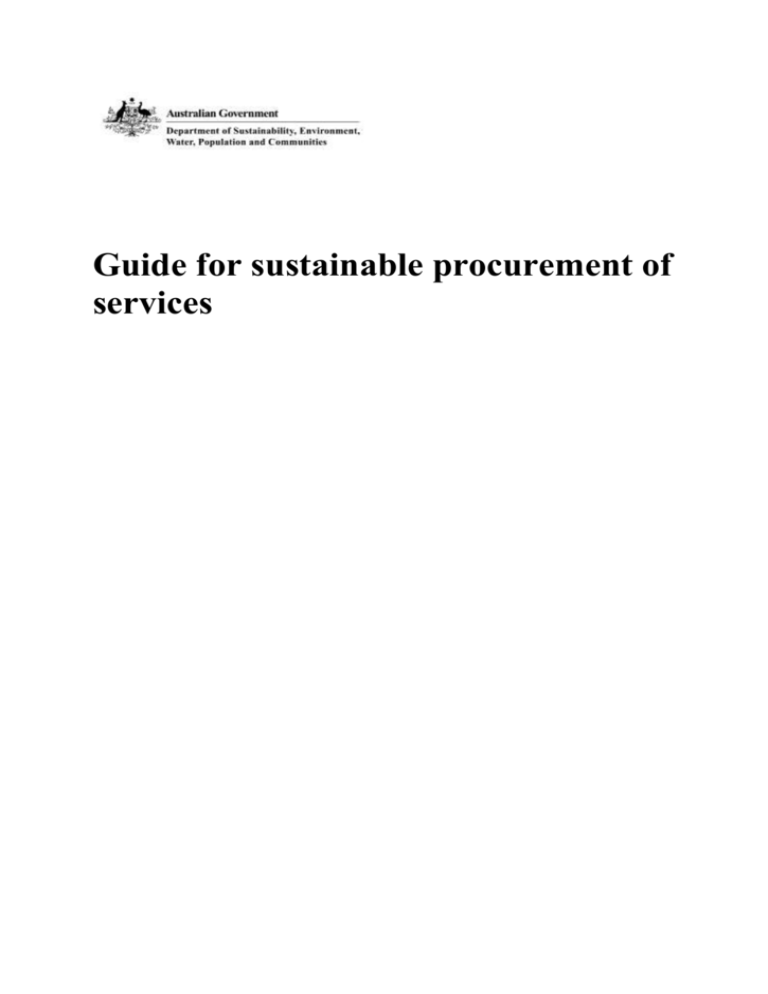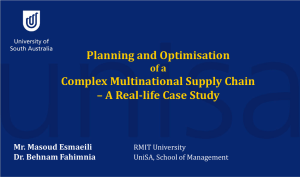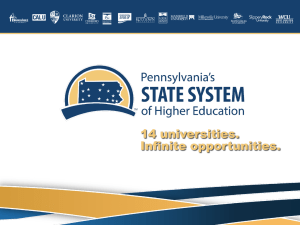
Guide for sustainable procurement of
services
Report prepared by ECO-Buy Limited
Level 4, 460 Bourke Street, Melbourne VIC 3000
www.ecobuy.org.au
© Commonwealth of Australia 2013
This work is copyright. You may download, display, print and reproduce this material in unaltered form only
(retaining this notice) for your personal, non-commercial use or use within your organisation. Apart from any use
as permitted under the Copyright Act 1968, all other rights are reserved. Requests and enquiries concerning
reproduction and rights should be addressed to Department of Sustainability, Environment, Water, Population
and Communities, Public Affairs, GPO Box 787 Canberra ACT 2601 or email public.affairs@environment.gov.au
2
Table of Contents
Purchasing guide for the procurement of services
4
Purpose of this guide
4
How to use this guide
4
Scope of this guide
4
Disclaimer
4
Getting started
5
Putting it into practice
9
Additional reference and guidance material
16
3
Guide for sustainable procurement of services
Purpose of this guide
The purpose of this guide is to identify and explain sustainability impacts associated with the
procurement of services, as well as to provide minimum and better practice sustainability
considerations for tender specifications and contract clauses for Australian Government
agencies.
How to use this guide
This guide is not intended to cover all stages of the procurement process. It particularly
focuses on the specification development, contract negotiation and contract management
stages of the procurement process.
This guidance will not be suitable for all agencies or for all procurement arrangements.
This guide is made up of two sections:
Part 1: Getting started – provides basic information on the key sustainability considerations
and a simple checklist to use.
Part 2: Putting it into practice – provides detailed information on what you can include in
tender specifications and contract clauses.
Scope of this guide
For the purposes of this guide, ‘services’ covers a range of professional and business officebased services, including legal, insurance, finance, audit and accounting, consulting and
management of resources (for example human, financial, intellectual).
Disclaimer
Every effort has been made to ensure that the material contained in this guide is up to date
and is based on accurate, credible and reliable sources of information at the time of
publishing.
Reference made to any specific ecolabel, standard, certification or policy does not constitute
endorsement.
Users of this guide are responsible for checking the latest legal and technical requirements,
as these may have changed since publication of this version of the guide.
4
Getting started
What are the key sustainability considerations for the procurement of
services?
The procurement of sustainable services presents different challenges than the procurement
of sustainable goods. It is usually a more straightforward process to identify what the
environmental and social issues are for a supply of goods, and therefore easier to identify
sustainable alternatives.
The provision of professional services – such as legal advice, audit or consultancy – is
responsible for a range of environmental and social impacts resulting from the supplier’s
operations, as shown in Figure 1.
There are two main aspects to consider for the procurement of sustainable services:
how the specific services to be provided to your agency could be delivered with
improved environmental and social impacts
the operations of the supplier organisation itself.
For procurement of a one-off piece of work, such as a consulting project, you might decide to
just focus on the sustainability impacts associated with the delivery of that particular service.
Procurements covering high-value or long-term arrangements, such as ongoing provision of
legal or audit services, offer more scope for the supplier to help your agency progress
towards its own sustainability goals. In this case it makes sense to consider the supplier’s
overall operations as well as the service being delivered.
5
Figure 1: Environmental and social impacts of professional services
6
Checklist of questions to ask
Below are some questions to ask when assessing the sustainability of potential service
providers:
Delivery of the contracted service
Energy and resource management
What steps will the supplier take to improve the energy/resource efficiency of its
activities associated with delivery of the contracted service – for example: energy
consumption related to equipment use?
Waste management
Does the supplier have a documented program addressing waste reduction or
elimination associated with the delivery of the contracted service – for example:
recycling?
Travel and transport
What steps will the supplier take to reduce travel and transport – for example:
change to holding a certain proportion of meetings with your agency via tele/video
conferencing rather than face to face?
Supplier’s operations
Environmental management
Does the supplier have a program or system in place to identify environmental
impacts relevant to the organisation, or a program/system under development
with a timeline for implementation?
Does the supplier have an environmental or sustainability policy in place or a
program/system under development with a timeline for implementation?
Energy and water management
Can the supplier provide a statement of the sources of purchased electricity (for
example: accredited GreenPower, coal)?
7
Does the supplier have a strategy/plan in place to achieve water reduction
targets, or a program/system under development with a timeline for
implementation?
Waste management
Does the supplier have a strategy/plan in place to achieve waste reduction targets
or a program/system under development with a timeline for implementation?
Supplier’s operations (continued)
Sustainable procurement
Does the supplier have a green/sustainable purchasing policy in place?
Has the supplier established sustainable purchasing guidelines or criteria for
choosing its direct suppliers – for example: guidelines that address environmental
management and labour practices?
Does the supplier have a policy to procure energy-efficient ICT equipment by applying
a recognised standard such as Electronic Product Environmental Assessment Tool
(EPEAT)?
Can the supplier demonstrate that it purchases copy paper with a high proportion
of recycled content?
Business practices
For office-based operations, does the supplier have a program or plan in place to
minimise its impacts – for example: a green office program?
Social benefits
Does the supplier have any initiatives in place that support disadvantaged or
marginalised groups in the community – for example: placing contracts with social
enterprises or providing training/employment/mentoring opportunities?
Social impacts in the supply chain
Does the supplier assess its supply chain against relevant labour standards?
8
Putting it into practice
Sample sustainability considerations in specifications for the procurement of
services
Minimum performance criteria can be used as a starting point in an approach to market if
sustainable procurement is fairly new to your agency, where the supply market does not
have a track record of minimising adverse environmental or social impacts or where many of
the potential suppliers are small businesses.
Where suppliers are already able to meet many of the minimum criteria, the better practice
performance criteria can be used as a tool to help drive continuous improvement and
communicate to the supply market that you are serious about sustainability.
Delivery of the contracted service
Minimum performance criteria
Better practice performance criteria
Minimum specification:
Better practice specification:
Energy and resource management
Energy and resource management
Tenderers are to provide details of
Tenderers should provide evidence
actions to improve the
of explored opportunities to improve
energy/resource efficiency or reduce
the energy/resource efficiency of
energy consumption associated with
activities associated with delivery of
delivery of the contracted service.
the contracted service.
Tenderers should provide evidence
Waste management
of steps taken to reduce energy
Tenderers are to provide details of
consumption associated with the
actions to reduce or eliminate waste
delivery of the contracted service,
associated with the delivery of the
such as energy consumption related
contracted service.
to equipment use.
Travel and transport
Tenderers are to provide details of
Waste management
Tenderers should have a
actions to reduce fuel use, reduce
documented program addressing
air pollution and mitigate emissions
9
associated with transport.
waste reduction or elimination
associated with the delivery of the
contracted service.
Travel and transport
Tenderers should provide
quantifiable evidence of
implemented initiatives that reduce
fuel use, reduce air pollution and
mitigate emissions associated with
transport – for example: change to
holding a certain proportion of
meetings via tele/video
conferencing.
Supplier’s operations
Minimum performance criteria
Better practice performance criteria
Minimum specification:
Better practice specification:
Environmental management
Environmental management
Tenderers are to have a program or
Tenderers should have implemented
system in place to identify
and maintained an environmental
environmental impacts relevant to
management system, certified to
the organisation, or a
ISO 14001 or equivalent, to reduce
program/system under development
environmental impacts and
with a timeline for implementation.
continually improve environmental
performance.
Tenderers are to have an
Tenderers should have a publicly
environmental or sustainability
policy in place, or under
available environmental or
development with a timeline for
sustainability policy in place.
implementation.
Tenderers should brief employees
Energy and water management
and others who work on behalf of the
10
Minimum performance criteria
Better practice performance criteria
Tenderers can provide a statement
organisation about the organisation’s
environmental or sustainability policy.
of the sources of purchased
electricity (for example:
Energy and water management
GreenPower, coal).
Tenderers should purchase a
Tenderers have a strategy/plan in
proportion of GreenPower
place to achieve water reduction
or, if no proportion of renewable
targets, or a program/system under
electricity is purchased, tenderers
development with a timeline for
should offset a minimum
implementation.
proportion of non-renewable
Waste management
energy sources in line with the
Tenderers have a strategy/plan in
National Carbon Offset Standard
(NCOS).
place to achieve waste reduction
targets, or under development with
Tenderers should measure and
a timeline for implementation.
record energy use on a minimum
quarterly basis (for example: of
electricity, gas, renewable energy)
based on receipts.
Tenderers should install energy
efficient lighting in offices and other
work areas where applicable.
Tenderers should install powersaving features on appliances where
possible. For example, an appliance
could be programmed to enter
‘suspend’ mode within 15 minutes of
becoming inactive.
Tenderers should have a
documented program addressing
water use reduction across offices
and facilities and provide a report.
11
Minimum performance criteria
Better practice performance criteria
Waste management
Tenderers should have a
documented program addressing
waste reduction or elimination of all
major waste streams across offices
and facilities (for example: implement
recycling initiatives) and provide a
report.
Sustainable procurement
Tenderers should demonstrate that a
green/sustainable purchasing policy
is in place.
Tenderers should demonstrate that
sustainable purchasing guidelines or
criteria are in place for choosing
direct suppliers – for example:
guidelines that address
environmental management and
labour practices.
Tenderers should demonstrate that
they purchase copy paper with a
minimum of 80 per cent recycled
content.
Social impacts
Tenderers should provide evidence
of initiatives that support
disadvantaged or marginalised
groups within the community.
12
How to assess sustainability considerations in the tender evaluation process
After specifying the sustainability performance criteria in the tender documentation, it is
recommended that sustainability be assessed in the overall tender evaluation process along with
organisation-specific criteria such as cost, quality and reliability.
If available, weightings should be assigned according to the agency’s objectives, priorities
and targets. For example, if an agency’s priority is to reduce the greenhouse gas emissions
associated with its activities, it makes sense to encourage suppliers of services to follow
emissions-reduction principles and assign a higher weighting to emissions-specific criteria in
the tender evaluation process.
An example of a weighting for a sustainability criterion in an approach to market is:
Documented evidence of the organisation’s commitment to improving its own environmental
performance. This may include policies, initiatives, environmental management systems,
sustainability reports and outcomes from these activities (5 per cent).
If your agency has not developed sustainability priorities or targets, think about which major
impacts are associated with delivery of the service, assess the potential size of the impacts and
set priorities or targets accordingly. For example, will the service involve large amounts of travel,
or will it generate large volumes of waste?
Relevant procurement-connected policies
National Waste Policy: Less Waste, More Resources
www.environment.gov.au/wastepolicy/index.html
You should also check the Department of Finance and Deregulation website to determine
whether there are any other relevant procurement-connected policies for a particular
procurement:
www.finance.gov.au/procurement/procurement-policy-and-guidance/buying/policyframework/procurement-policies/principles.html
Related ecolabels and standards
There are a number of ways to verify environmental and social credentials for suppliers of
services. For example, there are several credible and relevant ecolabels and standards from
Australia and overseas. These, or equivalents, are a good indication that the supplier takes
sustainability seriously and is working to reduce the adverse environmental or social impacts
associated with its operations:
GECA 35-2007 Administrative Services
13
ISO 14001 Environmental Management Standard
National Carbon Offset Standard (NCOS)
NSF P391-2012 General Sustainability Assessment for Services and Service
Providers
SA8000 Social Accountability Standard.
Sample sustainability clauses in contracts for the procurement of services
Reporting and management
Contract reporting requirements should highlight the sustainability outcomes achieved by
procuring environmentally and socially preferable goods and services.
It is recommended that sustainability reporting requirements be selected early in the
procurement process, included in tender documentation, incorporated into contract terms
and conditions and, most importantly, followed up by the contract manager.
Key performance indicators (KPIs) can be used to ensure that suppliers implement
progressive sustainability improvements over the term of the arrangement. For example:
A sustainability criterion may be set as part of KPIs if the potential supplier does not
have the capability or capacity to meet a particular sustainability requirement at the
specification development stage. For instance, the supplier may be required to
progressively increase the proportion of tele/video conferencing meetings instead of
meeting face to face.
A supplier could improve its practices over time by using better practice criteria that
are set as KPIs. For instance, the supplier may have to demonstrate within the first
12 months of the contract that it has established sustainable purchasing guidelines or
criteria for choosing its direct suppliers.
Other KPIs can be set based on the checklist on page 3 for assessing the sustainability of
potential services and service providers.
Possible contract requirements
Examples are provided below for possible inclusion in contracts. Note that some may be
more advanced than the procurement warrants, so tailor these to the complexity and
duration of the contract. You should always seek legal advice before drafting and inserting
clauses relating to environmental and social specifications into a specific contract.
14
Possible contract requirements: Delivery of the contracted service
The supplier should implement and report quarterly on initiatives to reduce energy use
associated with transport, to reduce kilometres travelled and greenhouse gas emissions.
The supplier should implement and report on initiatives to achieve a continual reduction in
energy use associated with the travel to/from client meetings over the contract period – for
example, change to holding a certain proportion of meetings via tele/video conferencing.
The supplier should implement and report on initiatives to reduce the volumes of paper used
in the delivery of the contracted service. This could include increasing the proportion of
material provided electronically, adopting demand management techniques and applying
sustainable design principles.
Possible contract requirements: Supplier’s operations
Environmental management
The supplier is required to provide bi-annual reports stating environmental impacts (including
those related to energy and water consumption and waste production) measured against a
baseline over the term of arrangement.
Energy management
The supplier is required to continually increase the proportion of GreenPower that is
purchased over the term of the arrangement.
Waste management
The supplier is required to report at least quarterly on its progress achieved towards waste
reduction, stating the proportion of waste that is diverted from landfill and the proportion of
waste that is recycled or composted as measured against a baseline.
The supplier is required to report on the proportion of discarded toner cartridges, electronic
equipment such as monitors and hard drives, mobile phones and fluorescent light globes
that are recycled, reused or refurbished.
The supplier is required to provide quarterly reports on paper usage, stating the number of
reams purchased, the number of reams used per full-time-equivalent staff member, the
proportion printed double-sided and the proportion recycled, against reduction targets.
15
Supply chain management
The supplier is required to communicate its sustainability practices to its suppliers and
stakeholders.
Additional reference and guidance material
Good Environmental Choice Australia, Administrative Services
http://www.geca.org.au/media/medialibrary/2012/02/geca-35-2007-administrative-servicessep-2011.pdf>
International Standards Organisation (ISO)
http://www.iso.org/iso/iso_14000_essentials
National Carbon Offset Standard
http://www.climatechange.gov.au/ncos
NSF International, NSF International Protocol NSF P391-2012 – General Sustainability
Assessment Criteria for Services and Service Providers
http://www.nsf.org/
Social Accountability International (SAI), SA8000 Standard
http://www.sa-intl.org/index.cfm?fuseaction=Page.ViewPage&PageID=937
16









